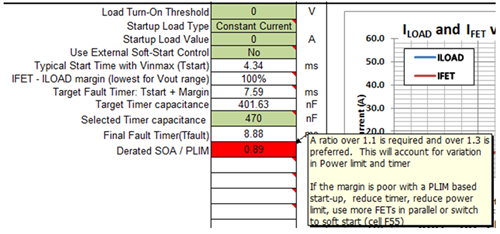SSZTBK0 march 2016 LM25066 , TPS24770
As the hot swap industry grows and systems require higher power, lower form factor, and lower cost solutions, component selection becomes more critical. Several calculations are involved and designing for worst-case scenarios can quickly become a challenge. Did you account for the timer pin’s minimum/maximum sourcing current, or de-rate the MOSFET’s safe operating area (SOA) curve over temperature? You need to consider these types of questions or else your design may experience startup issues – or even MOSFET or integrated circuit failure.
Design tools such as the LM25066 design calculator can help address these questions and perform the necessary calculations for you, saving hours of time and avoiding the risk of human error. Whether you are creating a new design or troubleshooting an existing one, consider using a design calculator to reveal areas of concern.
The most dangerous fault that can occur in a hot swap design is a short circuit on the output followed by the application of input power. The MOSFET will begin to turn on while in its saturation region (high VDS voltage), and power dissipation can be quite large. Some hot swap controllers (such as the TPS24770) may limit the power dissipation of the MOSFET in this condition, while other controllers may not.
In order to check whether the MOSFET is at risk, you’ll need to consider the magnitude and duration of the power that the hot swap controller can limit, and compare it to the magnitude and duration of the power that the MOSFET can handle without failure. A design calculator tool will walk you through this process by gathering all of the necessary inputs (such as maximum load current, ambient temperature, RDSON, thermal coefficient, current limit/power limit and SOA curve) and then compute how much margin the design has. If the MOSFET is at risk, the tool will highlight the cell in red (see Figure 1) and explain how to address the problem.
 Figure 1 Example of a Hot Swap Design
with a Poor MOSFET SOA Margin under Worst-case Conditions (Taken Using Step No.
4 of the LM25066 Design Calculator Tool)
Figure 1 Example of a Hot Swap Design
with a Poor MOSFET SOA Margin under Worst-case Conditions (Taken Using Step No.
4 of the LM25066 Design Calculator Tool)You can avoid many application issues by using a hot swap design calculator tool to help with component selection and to create, review or troubleshoot a hot swap circuit design.
Additional Resources
- Browse TI’s vast collection of hot swap design tools, unique to each product family.
- Watch video tutorials that walk you through each step of the design calculator tool.
- For a discussion of the detailed equations and methodology behind hot swap design, see the application note, “Robust Hot Swap Design.”